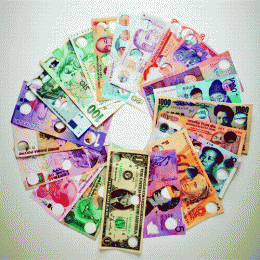Paper money worldwide contains bisphenol A

The cash register receipts that people place near paper money in billfolds, purses, and pockets has led to a worldwide contamination of paper money with bisphenol A (BPA) — a potentially toxic substance found in some plastics, thermal paper and other products. The amounts of BPA on dollars, Euros, rubles, yuans, and other currencies, are higher than in house dust, but human intake from currency is at least 10 times less than those from house dust. That's the conclusion of a new study in the ACS' journal Environmental Science & Technology.
Kurunthachalam Kannan and Chunyang Liao point out that manufacturers use BPA to make polycarbonate plastics used in some consumer products, including water bottles, sports equipment, and household electronics. Studies indicate that BPA acts as an endocrine disruptor — meaning it mimics the action of the sex hormone estrogen. Exposure to BPA has been linked to a variety of health problems. Although a recent study found traces of BPA in U.S. currency, nobody knew until now about BPA in paper money worldwide.
The scientists' analysis of 156 pieces of paper money from 21 countries found that all contained traces of BPA. The report notes, however, that "estimated daily intake from paper currencies were 10-fold lower than those reported from exposures due to [indoor] dust ingestion in the United States." The highest BPA levels were in paper money from Brazil, the Czech Republic and Australia, while the lowest occurred in paper money from the Philippines, Thailand, and Vietnam. Levels in U.S. notes were about average.
Kannan and Liao also found that the most likely source of the BPA in the currency is the thermal paper used in cash register receipts. They showed that receipts can transfer BPA onto cash when placed next to it or when a receipt is touched before handling currency. "Although high levels of BPA were measured in paper currencies, human exposure through dermal [skin] absorption appears to be minor," the article notes.
More information: “High Levels of Bisphenol A in Paper Currencies from Several Countries, and Implications for Dermal Exposure” Environ. Sci. Technol., Article ASAP. DOI: 10.1021/es200977t
Abstract
The sources of human exposure to bisphenol A (BPA) are not well characterized. Little is known about the presence of BPA in paper products, especially in paper currencies, and its implications for human exposure. In this work, paper currencies from 21 countries (N = 156) were analyzed for BPA, which was measured in 19 mm punches taken from three spots on the paper currencies. BPA was found in all paper currencies at concentrations ranging from 0.001 to 82.7 μg/g (mean 4.94; median 1.02) and the concentrations in samples taken from the middle portion of the currencies were higher than those taken from peripheral portions. We also examined the transfer of BPA from thermal receipt paper to currencies by placing currencies in contact with thermal receipt papers for 24 h in a wallet. Concentrations of BPA dramatically increased after 24 h of contact with thermal receipt papers, suggesting that thermal receipt paper is an important source of BPA in paper currencies. The estimated daily intake of BPA through dermal absorption from handling paper currencies was on the order of a few nanograms per day.
Provided by American Chemical Society















